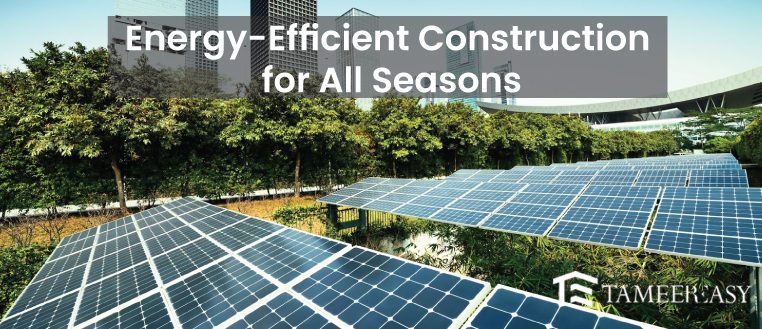Energy-efficient construction techniques have become more important in a world more concerned with the environment and growing energy expenses. Architects, engineers, and builders embrace the challenge of designing buildings that sustain pleasant temperatures all year while using the least energy possible.
Visit TameerEasy Store to Purchase Quality Construction Items
This article explores techniques and technology that guarantee peak performance throughout the year in energy-efficient construction.
The Importance of Energy-Efficient Construction
Building Sustainability and Environmental Responsibility
Building environmental responsibility and Sustainability Construction that uses less energy lowers energy costs and helps the environment. These structures reduce their environmental impact and greenhouse gas emissions by reducing energy demand.
Year-Round Comfort and Livability
All Year convenience and viability buildings that use less energy are made to provide continuous indoor comfort all year long. Regardless of the weather outside, they produce comfortable spaces by maintaining consistent temperatures, reducing drafts, and improving air quality.
Principles of Energy-Efficient Design
Effective Air Sealing and Insulation
An energy-efficient building must have adequate air sealing and insulation. High-quality insulation materials like foam, fibreglass, or cellulose and efficient air barriers prevent heat transfer and energy loss. These elements keep interiors cool in the summer and cosy in the winter.
Solar Gain and Glazing Solutions
By strategically placing windows and glass, it is possible to capture solar system heat gain in the winter while avoiding overheating in the summer. Heat transfer is balanced by low-emissivity (Low-E) coatings and double- or triple-glazed windows, providing thermal comfort.
Thermal Mass for Temperature Regulation
Thermal mass, such as stone or concrete, absorbs and holds onto heat before slowly releasing it to maintain constant indoor temperatures. As a result, less frequent heating and cooling adjustments are required.
Season-Specific Strategies
Winter Warmth and Comfort
Passive Solar Heating
South-facing windows allow sunlight to enter and organically heat interior rooms by utilizing the sun’s angle in the winter. This heat is stored in thermal mass materials for eventual release.
High-Efficiency Heating Systems
Winter warmth is maintained with the least energy use using energy-efficient heating technologies, such as radiant floor heating, heat pumps, or high-efficiency furnaces.
Summer Air Conditioning and Energy Saving
Cross-Breeze and Natural Ventilation
Designing for natural ventilation promotes fresh air circulation through structures, minimizing the need for air conditioning in the summer.
Reflective Roofing and Shading
Reflective roofing and shading is the sub-subheading. High solar reflectance roofing materials and shading features like awnings and overhangs assist in minimizing excessive heat gain, lowering the demand for powerful cooling systems.
Integrated Technologies for Year-Round Efficiency
Smart Thermostats and Energy Management Systems
Energy management systems and smart thermostats Intelligent thermostats adapt temperature settings based on what occupants like. Real-time data is available from energy management systems to improve HVAC performance.
Building-Integrated Renewable Energy Sources
Integrated renewable energy sources for buildings The building’s design incorporates wind and solar turbines to produce renewable energy, decreasing the need for conventional power sources.
Overcoming Challenges and Achieving Balance
Return on Investment and Cost-Effectiveness
Although the upfront expenses of energy-efficient construction may be a little higher, the long-term savings in energy bills frequently result in a quick return on investment.
Design Flexibility and Aesthetics
Flexibility and aesthetics in design Integrating energy-saving features should not sacrifice attractive design. Innovative architectural solutions that are both aesthetically pleasing and energy efficient are now possible thanks to modern technologies.
Conclusion
In summary, energy-efficient building incorporates innovative architectural design, cutting-edge technology, and environmental responsibility. Buildings can be constructed to offer year-round comfort while reducing their environmental impact by prioritizing insulation, ventilation, solar gain, and integrated systems. The principles of energy-efficient construction serve as a shining example of sustainable building techniques as we contend with changing seasons and climate challenges.








